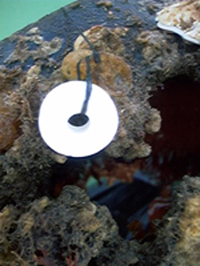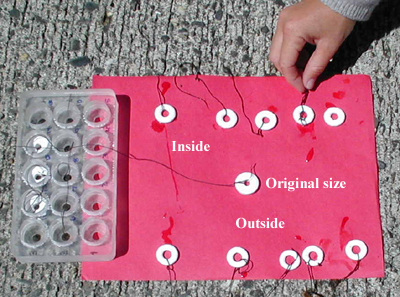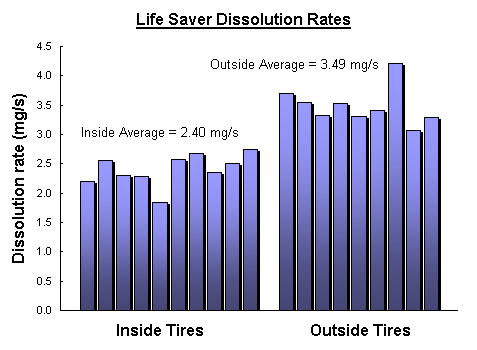
The floating dock we
worked on was oriented parallel to the coastline so that the tires lashed
to the shoreward side of the dock were subjected to less wave action than
those on the seaward side. In order to get a sense for the difference in
the hydrodynamic environment on opposite sides of the dock, we measured
and compared dissolution rates of Pep-O-Mint flavor Life SaversTM
attached to both inside and outside tires. Schabes (1990) showed that Five-Flavor
Life SaverTM dissolution
rates scale linearly with eddy diffusivity, which is in turn proportional
to the local shear velocity. Shear velocity is a measure of the shear stress
a fluid exerts on the surface of an object. Thus, we might expect our measured
dissolution rates to give us an idea of the relative magnitudes of the
shear velocities and their associated stresses on either side of
the dock.
 |
Our basic technique involved weighing a number of Life SaversTM, sewing them on to a sturdy tunicate called Chelyosoma productum that occurs commonly on both inside and outside tires, and exposing them to ambient flow conditions for a fixed period of time. We deployed the Life SaversTM in pairs (inside and outside tires opposite one another) for ten minutes, then let them dry at room temperature to constant weight. The dissolution rate for each Life SaverTM was calculated as the difference between its initial and final mass divided by the exposure time. Average dissolution rates for inside and outside tires were 2.40 and 3.49 mg/s, respectively, so assuming Shabes' linear relationship holds true for Pep-O-Mint flavor Life SaversTM as well, the tires on the outside of the dock experienced a shear velocity almost 50% greater, on average, than that experienced by the inside tires. |
| This picture shows the results of one of our Life SaverTM deployments. There is a clear size difference between the Life SaversTM that were on the inside of the dock and those that were on the outside. (It's easier to see this in the picture if you look at the relative sizes of the holes rather than at the candies themselves). Also shown is an undissolved Life SaverTM and our handy carrying tray. |  |
 |
The data that were generated show the trend even more clearly, with dissolution rates on the outside tires about 50% greater than those on the inside tires. |